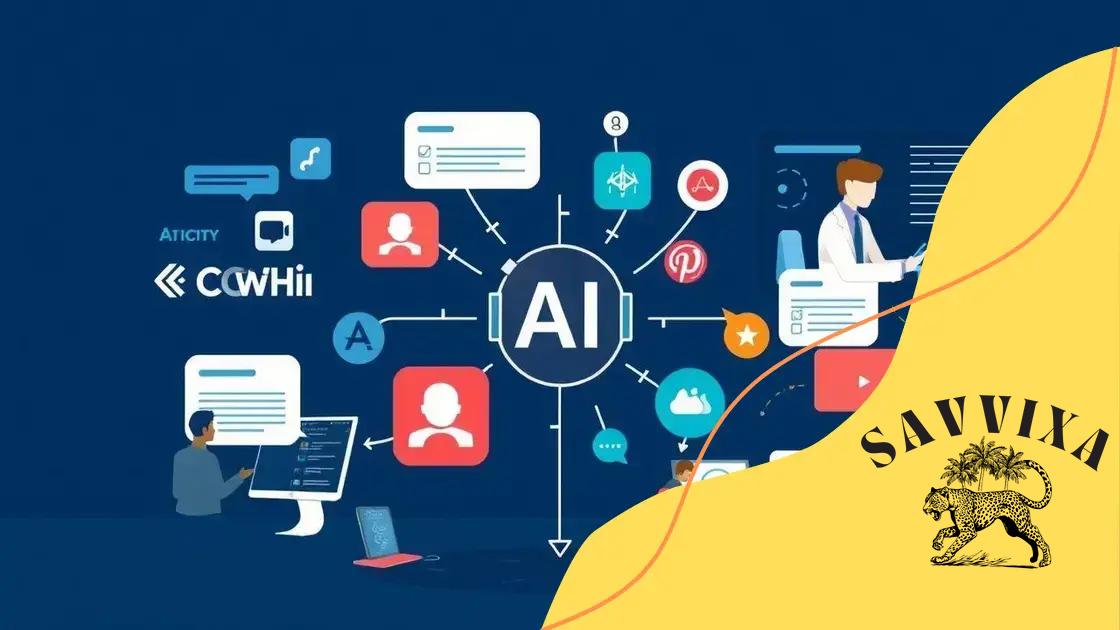How AI is revolutionizing personalized customer experiences

AI is revolutionizing personalized customer experiences by utilizing predictive analytics, chatbots, and voice technology to enhance interactions, improve satisfaction, and deliver tailored recommendations.
How AI is revolutionizing personalized customer experiences is changing the way businesses engage with their clients. Have you ever wondered how online retailers seem to know exactly what you want? Let’s dive into the fascinating world of AI!
Understanding the importance of personalization
In today’s world, personalization is paramount for businesses wanting to stand out. Customers desire experiences tailored just for them, and this is where AI comes into play.
By using data-driven insights, companies can better understand individual preferences. This targeted approach fosters deeper connections between brands and consumers. When customers feel recognized, their loyalty grows, resulting in repeat business.
Benefits of Personalization
1. Enhanced Customer Satisfaction
When experiences align with customer expectations, satisfaction levels shoot up. Businesses can watch as their clients become more engaged and enthusiastic.
- Customized recommendations based on previous interactions.
- Targeted marketing that resonates with audience needs.
- Improved user experience on digital platforms.
AI analyzes vast amounts of data swiftly, helping businesses create a seamless personalization journey. This efficiency not only saves time but also delivers value directly to customers. Moreover, understanding customer behavior aids in predicting future needs.
Creating Tailored Experiences
From online shopping to customer service, AI-driven personalization appears everywhere. Each touchpoint offers a unique chance to connect based on previous interactions.
With tools that gather real-time feedback, companies are better equipped to adjust offerings dynamically. Imagine browsing a website, and instantly receiving personalized suggestions that enhance your browsing experience. This capability is not only impressive but essential in today’s digital age.
Furthermore, personalization makes marketing efforts more effective. When customers receive messages aligned with their interests, their engagement rates soar. This paves the way for stronger relationships and increased trust in the brand.
AI technologies enhancing customer experiences
AI technologies are transforming the landscape of customer experiences. By leveraging data, businesses can enhance interactions, making them more fulfilling and efficient.
Some key AI technologies include chatbots, machine learning, and natural language processing. These tools work together to understand customer needs better and provide solutions in real-time.
Chatbots and Virtual Assistants
Chatbots play a significant role in customer service. They can answer questions instantly, freeing human agents to tackle more complex issues. This leads to faster response times and improved customer satisfaction.
- 24/7 availability for customer inquiries.
- Consistency in responses across all interactions.
- Quick resolution of common problems.
The implementation of chatbots ensures that customers always have support. In today’s competitive marketplace, this level of accessibility is crucial for retaining clients.
Machine Learning Enhancements
Machine learning analyzes customer behavior, predicting future needs based on past interactions. This allows businesses to offer tailored recommendations, boosting the personalization factor significantly.
For example, when users shop online, machine learning algorithms track their purchases and browsing history. This data generates suggestions that match their preferences, enriching their shopping experience.
Moreover, as these algorithms learn from more data over time, their recommendations become even more accurate. This leads to higher sales and improved customer loyalty.
Natural language processing aids in understanding customer feedback. By analyzing reviews and comments, businesses gain insights into areas of improvement. This data-driven approach ensures that companies adapt to customer needs effectively.
Real-life examples of AI in customer service

Many businesses are successfully using AI in their customer service strategies. These real-life examples show how technology can enhance user experiences.
Amazon is a prime example. They utilize AI to analyze customer queries and streamline their support system. Whether someone has a question about a product or needs help with an order, AI-driven tools provide quick responses, significantly reducing wait times.
Effective Use of Chatbots
Another shining example is Sephora. Their virtual assistant guides users through the shopping experience. It helps customers find the right products based on previous purchases and preferences.
- 24/7 accessibility for customer queries.
- Personalized beauty recommendations based on user profiles.
- Streamlined booking for make-up consultations.
This not only enhances customer satisfaction but encourages repeat business. Sephora’s success demonstrates how a well-designed AI system can lead to loyal customers.
AI in Customer Insights
Spotify takes advantage of AI to personalize user playlists and recommendations. By analyzing listening habits, Spotify suggests songs that users are likely to enjoy. This tailored approach keeps listeners engaged and drives higher user retention rates.
The use of AI in customer service extends to various industries. For instance, banks and financial institutions are deploying AI tools to answer inquiries. Such systems provide customers with accurate information, offering a smoother experience when handling transactions or managing accounts.
Real-life implementations showcase that AI is not just a trend. It’s changing how businesses approach customer service, improving satisfaction levels and operational efficiency.
Measuring the impact of AI on customer satisfaction
Measuring the impact of AI on customer satisfaction is essential in today’s business landscape. Understanding how AI influences customer experiences can help companies adapt and improve.
Analytics play a crucial role in this process. Businesses can track customer interactions with AI tools to gather valuable data. This data helps capture the sentiment of consumers through feedback and surveys.
Key Metrics to Consider
To effectively measure AI’s impact, several key metrics should be analyzed:
- Customer satisfaction scores (CSAT): Direct feedback from customers about their satisfaction level.
- Net promoter score (NPS): A metric that shows how likely customers are to recommend a business.
- Customer effort score (CES): Evaluates how easy it is for customers to interact with AI systems.
These metrics provide insights into how customers feel after using AI-enhanced services. For example, if a business sees a rise in CSAT scores, it is an indicator that their AI systems are making a positive difference in customer interactions.
Utilizing Surveys and Feedback
Surveys are a valuable tool for gauging customer sentiment. By asking targeted questions, businesses can understand what customers like and dislike. Feedback on AI interactions helps identify areas for improvement and helps refine algorithms over time.
For instance, if customers frequently report issues with a virtual assistant, businesses can adjust its capabilities. The goal is to create a seamless experience that meets consumer expectations.
Additionally, tracking changes in customer behavior can show AI’s effectiveness. For example, businesses may notice increased engagement after implementing AI tools.
Future trends in AI and personalized experiences
The future of AI in personalized customer experiences looks bright. As technology evolves, businesses are finding innovative ways to enhance user interactions.
One exciting trend is the integration of predictive analytics. This technology allows companies to anticipate customer needs before they even arise. By analyzing past behavior, AI systems can suggest products or services at the right moment.
Voice-Activated Assistants
Another growing area is the use of voice-activated assistants. Devices like Amazon’s Alexa and Google Assistant are becoming common. These tools allow customers to interact hands-free, making shopping more convenient.
- Seamless ordering through voice commands.
- Personalized recommendations based on previous purchases.
- Instant support with voice recognition capabilities.
As users become accustomed to voice technology, businesses must adapt to meet these expectations by integrating voice features into their platforms.
Hyper-Personalization
Hyper-personalization is also emerging as a crucial trend. It focuses on delivering tailored experiences on a much deeper level. Instead of general recommendations, AI uses detailed user data to create highly specific offers.
This can include customized emails, targeted advertising, and unique product suggestions based on individual preferences. By leveraging AI, brands can make customers feel unique and valued.
However, with greater personalization comes the need for proper data privacy. As businesses use more data, ensuring customer information remains secure will be vital. Striking a balance between personalized experiences and privacy will shape the future of AI in customer service.
FAQ – Frequently Asked Questions about AI in Customer Experiences
How does AI enhance customer satisfaction?
AI enhances customer satisfaction by providing personalized interactions, quick responses, and tailored recommendations based on user data.
What are the benefits of implementing chatbots?
Chatbots offer 24/7 customer support, reduce wait times, and ensure consistent responses, greatly improving the customer service experience.
How can businesses measure the impact of AI on customer experiences?
Businesses can measure the impact through customer satisfaction scores, net promoter scores, and customer feedback to identify strengths and areas for improvement.
What future trends in AI should businesses watch for?
Businesses should watch for advancements in voice-activated technology, hyper-personalization, and AI-driven predictive analytics to stay ahead in customer engagements.